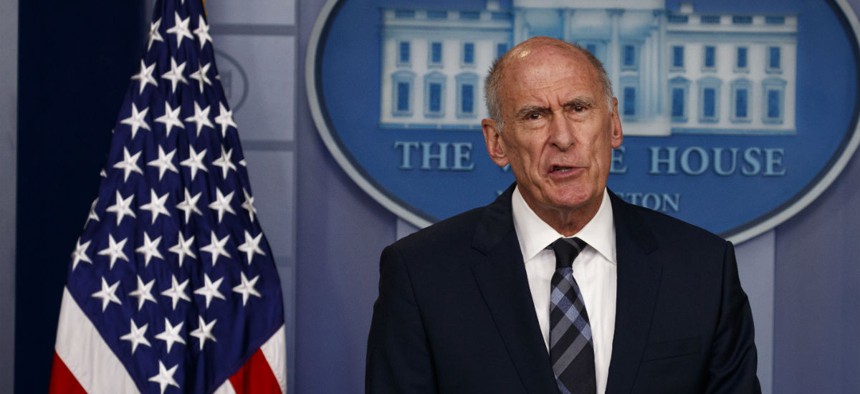National Intelligence Strategy Warns of Technological Threats to U.S.

Director of National Intelligence Dan Coats speaks during the daily press briefing at the White House, Aug. 2, 2018, in Washington. Evan Vucci/AP
Disruptive technologies will democratize capabilities previously available only to nation-states with plenty of resources.
Technology—or more specifically, technological threats—occupies a central theme in the National Intelligence Strategy released Tuesday by the Office of the Director of National Intelligence.
Revamped every four years, the strategy acts as a guidepost for the 17 intelligence agencies, and this—the fourth iteration of the strategy—suggests the IC will key in on how “disruptive technologies” could harm national security.
“Our adversaries are increasingly leveraging rapid advances in technology to pose new and evolving threats—particularly in the realm of space, cyberspace, computing, and other emerging, disruptive technologies,” the strategy states. “Technological advances will enable a wider range of actors to acquire sophisticated capabilities that were previously available only to well-resourced states.”
In the strategy, tech-based threats show up immediately after challenges posed by traditional adversaries, including Russia and China. Cyber threats received top billing, and “increasing awareness and understanding of adversaries’ use of cyber operations” is one of the IC’s top objectives laid out in the strategy. The IC seeks to expand tailored production and appropriate dissemination of actionable threat intel to support U.S. critical infrastructure and “expand our ability” to deter and counter malicious cyber activity. Regardless of the growing awareness of cyber threats, the strategy ominously states “nearly all information, communication networks and systems will be at risk for years to come.
“Cyber threats are already challenging public confidence in our global institutions, governance, and norms, while imposing numerous economic costs domestically and globally,” the strategy document states. “As the cyber capabilities of our adversaries grow, they will pose increasing threats to U.S. security, including critical infrastructure, public health and safety, economic prosperity, and stability.”
The strategy also delves into threats posed by “emerging technologies,” including artificial intelligence, automation and high-performance computing. While the strategy recognizes the potential benefits of these kinds of tech—increased intelligence collecting capabilities, for example—those benefits are also applicable to bad actors or adversaries. It references how internet technologies like social media can amplify political messages or ideologies or be used to undermine traditional institutions.
The strategy also suggests advances in nano- and bio-technologies “have the potential to cure diseases and modify human performance, but without common ethical standards and shared interests to govern these developments, they have the potential to pose significant threats to U.S. interests and security.”
“All of these issues will continue to drive global change on an unprecedented scale and the IC must be able to warn of their strategic effects and adapt to meet the changing mission needs in this increasingly unstable environment,” the strategy states.



